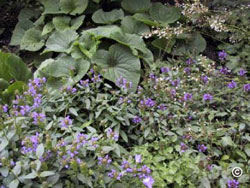Gardening in shady areas may seem to present great challenges, but with appropriate planning, soil preparation and maintenance, these areas can become beautiful, usable areas in the landscape. 
Plants that thrive in some degree of shade often evolved as woodland species, in the shade of deciduous or coniferous forests. Along with adapting to shade, they also adapted to lower light and the often acidic, humus soils of the forest. Most Colorado soils are mineral soils and are much more alkaline than those found in moist, temperate forests.
For successful gardening in an area where the shade is cast by a building, amend soil with compost or sphagnum peat moss to improve soil porosity and aeration. Concrete foundations can contribute to dry, alkaline soils. Organic matter dug into the soil will increase the moisture and nutrient holding capacity important for plant growth. Thoroughly work at least four inches of organic matter into the soil to a depth of at least eight inches.
Trees, especially those with shallow, fibrous roots, also deplete the soil of moisture and nutrients while shading an area. Most tree roots grow within a few inches of the soil’s surface and can be found in an area up to two to four times the width of its canopy. This area is known as the tree protection zone (TPZ) or critical root zone. Adding an additional layer soil or amendments or digging amendments into the soil in this area around the tree damages the tree’s roots and their ability to take up water, oxygen and nutrients. Areas outside of the TPZ can be amended in the fashion described above.
To add a bit of organic matter within the tree’s root zone, a soil aerator can be moved over the area and compost can be worked into the resulting holes.
While moisture is often critical to successful shade gardening, there are numerous hardy shrubs and perennials that can successfully tolerate dry shade and our alkaline soils.
For more information, see the following Colorado State University Extension fact sheet(s).
- Herbaceous Perennials
- Healthy Roots, Healthy Trees
- Vegetable garden: Soil Management and Fertilization
- Xeriscaping: Ground Cover Plants
- Choosing a Soil Amendment
- Deciduous Shrubs



